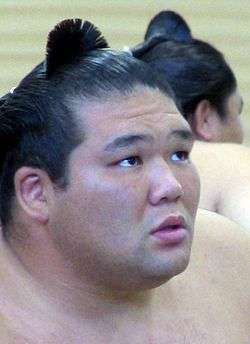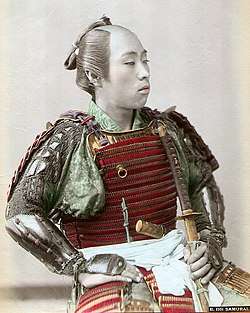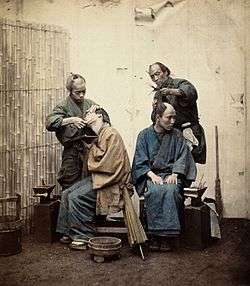Chonmage
The chonmage (Japanese: 丁髷) is a form of Japanese traditional topknot haircut worn by men. It is most commonly associated with the Edo period and samurai, and in recent times with sumo wrestlers. It was originally a method of using hair to hold a samurai helmet steady atop the head in battle, and became a status symbol among Japanese society.
A traditional Edo-era chonmage featured a shaved pate. The remaining hair, which was long, was oiled and tied into a small queue which was folded onto the top of the head in the characteristic topknot.
Sumo
In modern times, the only remaining wearers of the chonmage are sumo wrestlers. This style of chonmage is slightly different, in that the pate is no longer shaved. However, the hair may be thinned in this region or the crown of the head shaved, called nakazori, to allow the topknot to sit more neatly.
Sumo wrestlers with sekitori status are required on certain occasions to wear their hair in a more elaborate form of topknot called an ōichō or ginkgo leaf style, where the end of the topknot is splayed out to form a semicircle, resembling a hand fan (sensu). Given the uniqueness of the style in modern Japan, the Sumo Association employs specialist hairdressers called tokoyama to cut and prepare sumo wrestlers' hair.
The chonmage is of such symbolic importance in sumo that snipping it off is the centerpiece of a wrestler's retirement ceremony. Dignitaries and other important people in a wrestler's life are invited to take one snip, with the final one taken by his trainer.
In modern fashion

Outside Japan, so-called "samurai buns" have been worn by a minority of young British, Australian, Canadian, European, and American men during the mid-2010s.[1] Unlike the traditional chonmage, the hair on top of the head is kept long, and the back and sides are shaven[2] This hairstyle, reminiscent of the samurai topknots in jidaigeki movies, was popularised by celebrities including Orlando Bloom, Jared Leto, Zayn Malik, TOWIE's Joey Essex,[3] Harry Styles,[4] and Brent Burns.[5]. Although this haircut is somewhat similar to the Japanese topknot, it is visually more closely related to the topknots worn by western barbarians, such as the Lombards, Vikings, and Cumans. The medieval historian Paul the Deacon, in his description of the traditional barbarian style of the Lombard nation, describes their hair thus so, "they uncovered the flesh of their heads by shaving all around the neck, sides, and back of the head until the nuchal zone. The hair on the top, left long, was parted in the middle and hung down to the corners of their mouths." (HL IV.22). This perfectly describes the modern western top knot as it appears untied.
See also
| Wikimedia Commons has media related to Chonmage. |
References
- ↑ "The Samurai Hairstyle – Or How Men With Curly Hair Use Buns! – The Lifestyle Blog for Modern Men & their Hair by Curly Rogelio". The Lifestyle Blog for Modern Men & their Hair by Curly Rogelio. Retrieved 24 September 2015.
- ↑ Nikita Mukherjee. "Mens Hairstyle In Focus: The Man Bun". www.mensxp.com. Retrieved 24 September 2015.
- ↑ "Joey Essex sports the tiniest of ponytails". Mail Online. Retrieved 24 September 2015.
- ↑ "Harry Styles and Ollie Proudlock love them but would YOU let your boyfriend rock a man bun? – Daily Mail Online". Mail Online. Retrieved 24 September 2015.
- ↑ "Brent Burns has turned a larger-than-life NHL star". Retrieved 2017-04-09.

